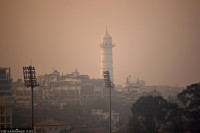Climate & Environment
Climate shocks add risks to Nepal’s power projects
Hydropower assets face risks due to erratic precipitation, glacial melting, and high rates of runoff and erosion.
Prithvi Man Shrestha
People’s Hydropower Company Limited had planned on completing the 54MW Super Dordi Hydropower Project B in 2021 before the landslide debris brought by the Dordi stream in Lamjung damaged the project’s dam in the monsoon last year.
“We had completed 95 percent of the dam-related work, and the project’s overall physical progress was over 70 percent when the massive debris brought by floods damaged the intake,” said Keshav Bahadur Rayamajhi, managing director of People’s Hydropower Limited.
It was one of the hydropower projects in the Dordi corridor to be badly affected by the floods and landslides. As a result, the project faced both time and cost overruns. “We are in the process of completing the project, which should have been ready last year, in the next two-three months,” said Rayamajhi. “It also increased our cost by around Rs400 million.”
According to the Independent Power Producers’ Association of Nepal (IPPAN), the umbrella organisation of private sector power developers, about two dozen projects across the country were damaged in 2021 due to floods and landslides
“They suffered damage worth around Rs10 billion,” Mohan Kumar Dangi, a vice-president of IPPAN, told the Post.
Nepal has seen increased and erratic incidents of flooding and landslides in recent years, which many experts blame on climate change.
The World Bank said in its Nepal Development Update released in early October that climate change is visibly impacting the country. The number of flood events has doubled in recent years; storms, erosion and landslides are also on the rise, resulting in the loss of life and livelihoods.
Mountains are warming quicker than plains, triggering melting of ice and permafrost and an increase in the risk of landslides. Nepal ranks 10th among the most affected countries in the world, according to the Global Climate Risk Index.
The country’s hydropower projects also face the risk of massive damage as many of them are run-of-the-river and the infrastructure has been built in hilly areas that are prone to landslides.
The country is also seeing untimely rainfalls, which are also damaging the power infrastructure including hydropower and transmission lines.
Monsoon is usually over by October, but the incessant rainfall during the Dashain festival this year damaged a transmission tower at Beldangi of Lamahi Municipality of Dang, disrupting electricity to high energy consuming industrial units such as cement factories.
Likewise, damage caused to another transmission tower at Attariya, Kailali obstructed the evacuation of power from some hydropower projects in farwestern Nepal, including the 30MW Chameliya, 8.8MW Naugarh Gad and 8MW Upper Naugarh Gad hydropower projects in Darchula, for two days.
“Due to climate change, high altitude rainfalls are growing, contributing to floods and landslides in the uplands,” said Madhukar Upadhya, an expert on watershed issues and climate change. “For example, the mountain district of Manang faced massive rains and landslides last year.”
According to him, the run-of-the-river projects are facing damage to their infrastructure including machinery while storage-type projects face the risk of growing sedimentation, reducing the operational period of such projects.
A World Bank report also said that Nepal faces massive infrastructure losses to climate changes related events.
Even with no additional warming, there is the probability of floods destroying 2.6 percent of capital stocks (plant, equipment, and other assets that help with production) in built infrastructure over 50 years, the World Bank said in the Nepal Development Update report.
In its Country Climate and Development Report released in September, the global lender called for building resilience against the climate change impact on the hydropower sector.
Building such resilience “will be key for Nepal’s energy security and energy future,” the report says.
Hydropower assets face climate risks due to erratic precipitation, glacial melting, and potential increases in the risks of high rates of runoff and erosion, landslides, and glacier lake outburst floods (GLOFs), the report ‘Country Climate and Development Report’ states.
“Run-of-the-river plant productivity fluctuates with river runoff volume and resilience is affected by sedimentation caused by natural processes and poor land and forest management as well as extreme weather events.”
With many hydropower projects built with the investment of government entities, the report warned Nepal government may have to bear the cost of damage to hydropower assets to be caused by climate-related disasters.
“Financial and climate-related risks to the hydropower sector have the potential to transmit material-contingent liabilities to the sovereign, due to the NEA’s ownership of a significant share of the country’s hydropower assets,” the report says.
Although the share of the NEA in overall hydropower capacity has been diminishing over the years, it is still significant.
There are projects totaling 2,781 MW under construction by IPPs and 943 MW by the NEA, according to the World Bank report.
Besides frequent and intense floods and landslides, the country is also facing the risk of GLOFs.
“The hydropower plants that are located within 50-100 km downstream of potential glacial lakes are expected to be more affected by potential GLOF events,” a report titled ‘Vulnerability and Risk Assessment and Identifying Adaptation Options’ released by the Ministry of Forest and Environment in October last year, states. “This is because the peak discharge generated by GLOF events within such distances can be higher than the design flood values of the hydropower plants.”
According to the report, the higher monsoon peak flows could increase the risks of extreme flows and floods and damage hydroelectricity plants resulting in high repair costs and lost incomes.
There are 21 potentially dangerous glacial lakes including 18 in the Koshi basin, two in the Gandaki basin and one in the Karnali basin, according to the report
Nepal has a history of hydropower plants being affected by GLOF events.
The Zhangzangbo GLOF on July 11, 1981 caused substantial
damage to the diversion weir of the Sunkoshi Hydropower Plant.
Similarly, the Dig Tsho GLOF on August 4, 1985 in the Khumbu region destroyed the Namche small hydroelectric plant.
Likewise, the Jure landslide in the Sunkoshi River in August 2014 badly affected the hydropower plants downstream. Nearly 10 percent of the nation’s hydropower capacity, or some 67 MW, was severed by the landslide, submerging a 5MW power plant and disconnection of the power supply with the Bhotekoshi (45MW) and Sunkoshi (10 MW) projects, according to the report.
There is an enormous amount of investment in the hydropower plants that
are in construction and survey phases.
“To protect the huge development investment in the sector, there is an urgent need to increase awareness among hydropower developers/investors and the private sector as a whole. This needs to be supported by policy instruments such as regulations…for adoption of necessary risk mitigation measures in the sector,” the report says.
Upadhya said risks of climate change must be internalised in the project design. “Installation of an early warning system would also help minimise the risks to hydropower infrastructure. A hydropower project can open the doors of the dam to let the debris brought by floods pass through after getting early warning about floods,” he added.
There is, however, a silver lining despite massive risk to hydropower plants from climate change.
According to the World Bank’s Country Climate and Development report, accelerated glacial and snow melt, combined with greater anticipated precipitation, strengthens the case for further development of hydropower. “It also offers opportunities to increase the capacity and efficiency for hydropower generation,” the report says.
For example, early melting of ice this year helped Nepal to produce more power than usual in the dry season.
Even though India stopped power flow to Nepal under government-to-government agreements this dry season, Nepal didn't face severe power cuts. Nepal also could export power to India from as early as June. “Such benefits may be short-lived,” said Upadhya. “Water flow in the rivers may be affected in the longer-term if the rate of snow deposits in the Himalayan mountains comes down in the winter due to global warming.”




 12.12°C Kathmandu
12.12°C Kathmandu










